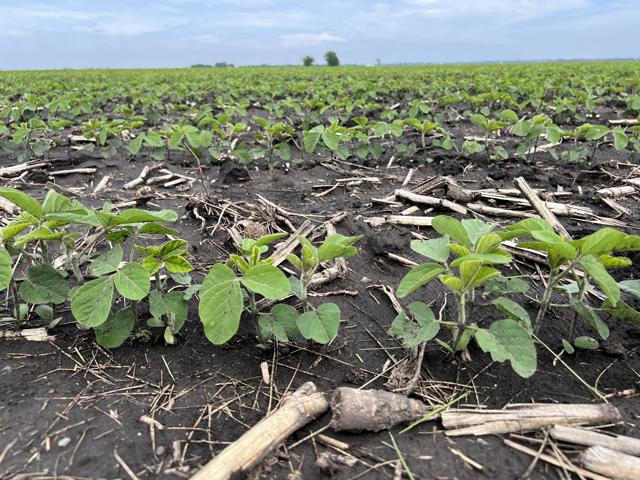Watch for Early Soybean Pests
Reasons to Scout Early Planted Soybeans Now
DECATUR, Ill. (DTN) -- Soybeans may have the reputation of being tough and resilient, but the crop still needs early season assessments.
Stephanie Porter, outreach agronomist with the Illinois Soybean Association, told DTN that soybeans in her state are generally faring well this year, despite germination and growth being slowed by cold weather conditions in early May. But reports of some pest activity and other issues, such as flooding, have her encouraging farmers to take stand counts -- now.
"Farmers often walk corn but figure soybeans will fill in and make up for losses. They can -- to a point," she said.
In general, a diminished soybean stand below 75,000 plants per acre is considered a possible replant or repair scenario in Illinois, Porter said. "And we're pushing the calendar on opportunities to replant. So, we need to be making those assessments," she added.
CUTWORM ALERT
While black cutworm is a notorious clipper of corn, the pest also dines on soybean. Kelly Estes of the Illinois Pest Survey issued alerts of significant black cutworm moth flights in April and offered a prediction for a projected cutting date in western Illinois of May 18. Porter said she has heard some reports of black cutworms cutting soybeans in Illinois this week.
Other states have similar cutworm monitoring networks. Some are run by volunteers who set pheromone traps to help monitor migrations. Check with your state extension educators.
Black cutworms like to infest fields that are later planted or consist of vegetation. Younger cutworm larvae feed at night or on cloudy days above ground. As the larvae get older, they prefer to stay within the soil and can cut plants below, at, or above ground level.
P[L1] D[0x0] M[300x250] OOP[F] ADUNIT[] T[]
Scouting for cutworms should start at emergence and continue until plants are past the V5 growth stage. Check for leaf feeding, wilted, or cut plants. If you see any signs of cutworm infestation, dig around the base of the plant to find the cutworm larvae.
"They can be very hard to find, especially since they are the color of soil. But it's important to find them while they are still little. For insecticide treatments to be effective, cutworms need to be present and less than one inch in length," Porter said.
"I've found them throughout the day, but the hotter it gets, the lower in the soil they go. They tend to blend right in," she added.
Find more information on black cutworm in soybean here: https://extension.umn.edu/… and http://extension.cropsciences.illinois.edu/… and https://extension.entm.purdue.edu/… and https://crops.extension.iastate.edu/….
FLOODING AND MORE
Southern parts of Illinois have struggled with some flooding damage, Porter said. "We had some significant downpours in some areas and large areas where the crop is sitting in water and isn't getting air."
Crusting was causing some stand losses in areas that had been dry when rains came. Parts of eastern Illinois remain dry, she added.
"There have been reports of slug injury, but that usually ends as temperatures rise," Porter noted. While she's not heard reports of injury because of PPO herbicides, that problem is not uncommon this time of year. There have been some hail injury reports this season.
"Soybeans are fairly plastic and can usually fill in and compensate. The problem is we can have spots in the field that are maybe 50,000 plants per acre. That's when the questions on whether to replant or spot in get tough," she added.
For a DTN article on replanting soybeans go to: https://www.dtnpf.com/….
Funded by the United Soybean Board through the soybean checkoff program, the Science for Success partnership brings together Extension specialists from dozens of land-grant institutions across the country, representing more than 80% of U.S. soybean acres. The group recently published a national fact sheet to guide soybean replanting decisions that can be found here: https://soybeanresearchinfo.com/….
Here's some help on how to take soybean stand assessments:
-- https://www.ilsoyadvisor.com/…
-- https://crops.extension.iastate.edu/…
-- https://extension.psu.edu/…
-- https://www.extension.purdue.edu/…
Pamela Smith can be reached at pamela.smith@dtn.com
Follow her on Twitter @PamSmithDTN
(c) Copyright 2023 DTN, LLC. All rights reserved.






